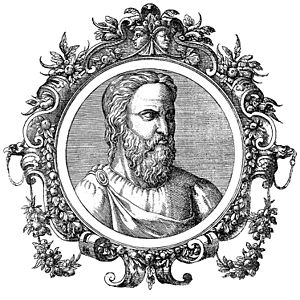Aretaeus of Cappadocia facts for kids
Quick facts for kids
Aretaeus of Cappadocia
|
|
|---|---|
 |
|
| Born |
Ἀρεταῖος
|
| Nationality | Greek |
| Occupation | Physician |
| Years active | 2nd century AD |
Aretaeus (Greek: Ἀρεταῖος) was one of the most famous ancient Greek doctors. Not much is known about his life. He probably came from or lived in Cappadocia. This was a Roman area in Asia Minor, which is modern-day Turkey. He likely lived in the second half of the 100s AD. People often called him "the Cappadocian" (Καππάδοξ).
Contents
Understanding Diseases: Aretaeus's Method
Aretaeus wrote his medical books in Ionic Greek. His eight books about different diseases are still around today. They are thought to be some of the most important medical writings from ancient Greece and Rome.
Spotting Symptoms and Diagnosing Illnesses
Aretaeus was very good at noticing the small details of how people felt when they were sick. He was also excellent at figuring out what disease someone had. He mostly followed the ideas of Hippocrates, who is known as the "Father of Medicine." However, Aretaeus also had his own ideas. He wasn't afraid to try new ways to help patients if he thought it would make them better.
Discovering New Illnesses
Aretaeus was the first to describe many diseases very clearly. For example, he gave classic descriptions of:
- Asthma (a breathing problem)
- Epilepsy (a brain disorder that causes seizures)
- Pneumonia (a lung infection)
- Tetanus (a serious bacterial infection)
- Different types of cancer, like uterine cancer and liver cancer
He also carefully described problems with the brain and mind. He wrote about hysteria, headaches, mania (extreme excitement), and melancholia (deep sadness). Some of his ideas about brain disorders were similar to what doctors discovered much later.
First Descriptions of Coeliac Disease and Diabetes
Aretaeus was the first to write about coeliac disease. He called it "disease of the abdomen," or koiliakos. He also wrote the first known description of diabetes. This is a condition where the body has trouble controlling blood sugar.
His Approach to Treatment
Aretaeus's way of treating diseases was smart and simple. It was also more active than some other medical groups of his time. He didn't stick to just one set of beliefs. Many experts agree that his descriptions of diseases and how to treat them have stood the test of time. This means his ideas were often proven right by later medical discoveries.
Aretaeus's Important Books
Aretaeus's work includes eight books. They are mostly complete, though a few parts are missing. These books cover:
- Two books on the causes and signs of sudden (acute) diseases.
- Two books on the causes and signs of long-lasting (chronic) diseases.
- Two books on how to cure sudden (acute) diseases.
- Two books on how to cure long-lasting (chronic) diseases.
His writings were first put into Latin in 1552. The first Greek version came out in 1554. Over the years, many scholars have studied and published his works. This shows how important his medical knowledge was.
See also
 In Spanish: Areteo de Capadocia para niños
In Spanish: Areteo de Capadocia para niños

